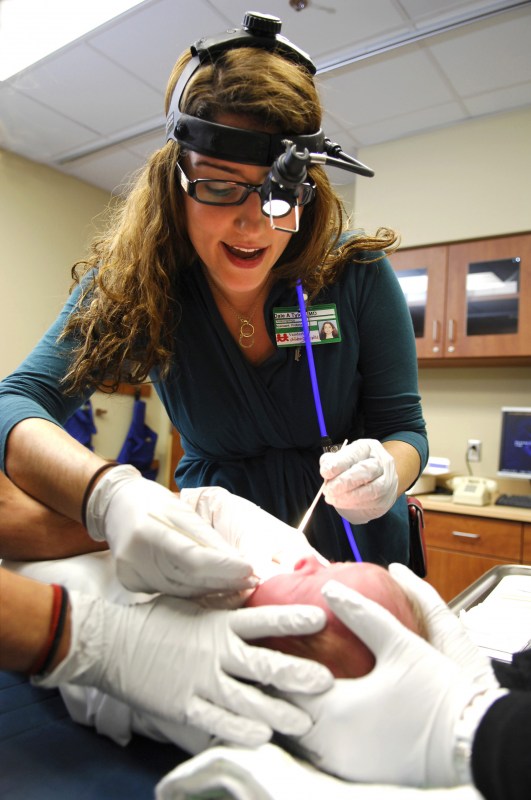
Dale Tylor, M.D., performs a frenotomy on Andrew Dodd to correct his tongue-tie condition. (photo by Anne Rayner)
Children’s Hospital helping to untangle ‘tongue tie’ condition
There may be an easy solution for some mothers struggling to breastfeed their children, say doctors and researchers at Monroe Carell Jr. Children's Hospital at Vanderbilt.
An easily missed “tongue-tie” condition could be preventing newborns from feeding properly, and it can often be fixed with a simple outpatient procedure.
Doctors at Children’s Hospital are currently researching the issue, and have streamlined a process to quickly diagnose and treat the problem before new mothers abandon breastfeeding. Initial findings show that after a tongue-tie-clipping procedure, known as a “frenotomy,” is performed on infants, well over two-thirds of women are able to begin successfully breastfeeding their babies.
Studies say ankyloglossia, or tongue-tie, is present in somewhere between 4 percent and 10 percent of the newborn population. The most common type of ankyloglossia, where a tight band of tissue results in a heart-shaped tongue indentation in the front of the mouth, is relatively easy to identify.
Another type of tongue-tie, posterior ankyloglossia, is harder to detect.
More than half of tongue tie cases treated at Children’s Hospital are classified as posterior.
“When you look at the posterior type of tongue-tie with your eyes, you can’t always see it,” says Dale Tylor, M.D., assistant professor of Pediatric Otolaryngology at Children’s Hospital. “But when you feel it with your finger, or push it back with a specialized instrument, you can really tell that there is something restricting the movement of the tongue.”

April Dodd holds her son, Andrew, before his recent procedure to correct tongue tie. (photo by Anne Rayner)
Tylor says that posterior tongue-tie is an under-diagnosed phenomenon in infants. A quick snip can remedy the problem, and the procedure rarely requires general anesthesia in babies.
She and her team have been working closely with lactation consultants at Children’s Hospital and other area hospitals to direct frustrated mothers to Vanderbilt’s Pediatric Otolaryngology clinic.
Lactation consultants are diagnosing it, says Tylor, because mothers often feel more comfortable talking to them about sensitive issues, such as nipple pain, than they do with their physician or the baby’s pediatrician.
“For an infant to properly breastfeed, the baby needs to move his or her tongue to their lips to allow sucking to occur,” explains Tylor. “If there’s a tethering, the baby has a hard time latching on and uses his or her gums or lips. It becomes painful for the mom, and can even cause bleeding.”
Tylor says other indicators are when a baby breastfeeds for up to an hour at a time, is frustrated during the feeding, or falls asleep before full. A whole day can be spent just feeding the baby, which can cause parents to supplement with formula or give up breastfeeding altogether.
In addition, Children’s Hospital’s findings show that infants who were treated early are less likely to have speech problems.
At Children’s Hospital, mothers are seen within a week after calling for an appointment.
With widespread knowledge about the obvious health benefits of breastfeeding, Tylor says women are subjected to high levels of anxiety, frustration or guilt when things don’t go as planned.
“Health professionals and society are telling mothers that breast milk is the best nourishment for their child, and we need to follow through and help the moms who are having problems feeding because of tongue-tie,” she says.
“The goal is to increase public awareness among surgeons and pediatricians, and, more importantly, among parents who can then advocate for themselves.”
For more information, contact the Pediatric Otolaryngology clinic at 936-8176 or go to http://www.childrenshospital.vanderbilt.org/interior.php?mid=579.













